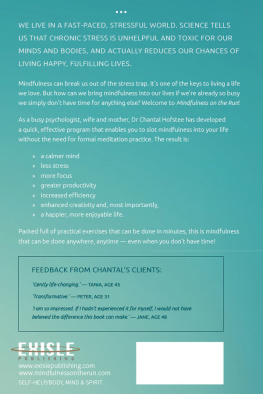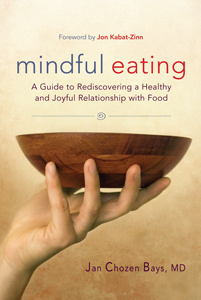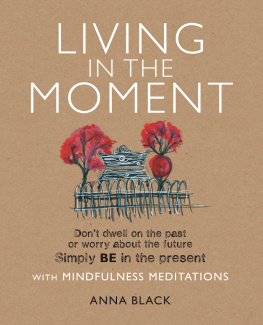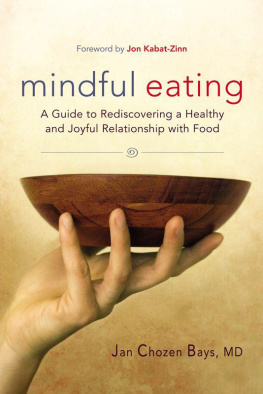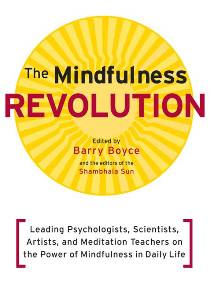Sign up to receive news and special offers from Shambhala Publications.

Or visit us online to sign up at shambhala.com/eshambhala.
Mindfulness on the Go
Simple Meditation PracticesYou Can Do Anywhere
Jan Chozen Bays, MD

SHAMBHALA
Boulder
2017
Shambhala Publications, Inc.
4720 Walnut Street
Boulder, Colorado 80301
www.shambhala.com
2011, 2014 by Jan Chozen Bays
This book is an abridged edition of How to Train a Wild Elephant (Shambhala, 2011).
All rights reserved. No part of this book may be reproduced in any form or by any means, electronic or mechanical, including photocopying; recording; or by any information storage and retrieval system; without permission in writing from the publisher.
Library of Congress Cataloging-in-Publication Data
Bays, Jan Chozen, author.
[How to train a wild elephant and other adventures in mindfulness]
Mindfulness on the go: simple meditation practices you can do anywhere /
Jan Chozen Bays.
pages cm(Shambhala pocket classics)
eISBN 9780834841024
ISBN 9781611801705 (paperback)
1. Spiritual lifeBuddhism. 2. MeditationBuddhism. I. Title.
BQ5670.B39 2014
294.34435dc23
2014005488
Contents
People often say to me, Id love to practice mindfulness, but Im so busy I cant seem to find the time.
Most people think of mindfulness as something they must squeeze into an already full schedule of working, raising children, caring for a home. In truth, making mindfulness part of your life is more like a game of connect the dots, or like a paint-by-numbers kit. Do you remember those pictures where each small area is labeled with a number that tells you which color to use? As you fill in all the brown areas, then the greens and the blues, a pleasing picture begins to emerge.
Mindfulness practice is like that.You begin with one small area of your life, lets say how you answer the phone. Each time the phone rings, you pause to take three long, slow breaths before you pick it up. You do this for a week or so, until it becomes a habit. Then you add another mindfulness practice, such as mindful eating. Once this way of being present is integrated into your life, you add another. Gradually you are present and aware for more and more moments of the day. The pleasing experience of an awakened life begins to emerge.
The exercises in this book point to many different spaces in your life that you can begin to fill in with the warm colors of openhearted mindfulness. I am a meditation teacher, and I live at a Zen monastery in Oregon. Im also a pediatrician, a wife, a mother, and a grandmother, so I understand well how stressful and challenging daily life can become. I developed many of these exercises to help me be more aware, happy, and at ease within the flow of a busy life. I offer this collection to anyone who would like to become more fully present and enjoy the small moments of their life. You dont have to go to a month-long meditation retreat or move to a monastery to restore peace and balance to your life. They are already available to you. Bit by bit, daily mindfulness practice will help you uncover satisfaction and fulfillment in the very life you are living now.
WHAT IS MINDFULNESS AND WHY IS IT IMPORTANT?
In recent years, interest in mindfulness has grown enormously among researchers, psychologists, physicians, educators, and among the general public. Theres now a significant body of scientific research indicating the benefits of mindfulness for mental and physical health. But what exactly do we mean by mindfulness?
Heres the definition I like to use:
Mindfulness is deliberately paying full attention to what is happening around you and within youin your body, heart, and mind. Mindfulness is awareness without criticism or judgment.
Sometimes we are mindful, and sometimes we are not. A good example is paying attention to your hands on the steering wheel of a car. Remember when you were first learning to drive, and how the car wobbled and wove its way along the road as your hands clumsily jerked the wheel back and forth, correcting and overcorrecting? You were wide awake, completely focused on the mechanics of driving. After a while your hands learned to steer well, making subtle and automatic adjustments. You could keep the car moving smoothly ahead without paying any conscious attention to your hands. You could drive, talk, eat, and listen to the radio, all at the same time.
Thus arises the experience we have all had, of driving on automatic pilot. You open the car door, search for your keys, back carefully out of the driveway, and... you pull into the parking garage at work. Wait a minute! What happened to twenty miles and forty minutes between house and job? Were the lights red or green? Your mind took a vacation, in some pleasant or distressing realm, as your body deftly maneuvered your car through flowing traffic and stoplights, suddenly awakening as you arrived at your destination.
Is that bad? Its not bad in the sense of something you should feel ashamed or guilty about. If you are able to drive to work on autopilot for years without having an accident, thats pretty skillful! We could say that its sad, though, because when we spend a lot of time with our body doing one thing while our mind is on vacation somewhere else, it means that we arent really present for much of our life. When we arent present, it makes us feel vaguely but persistently dissatisfied. This sense of dissatisfaction, of a gap between us and everything and everyone else, is the essential problem of human life. It leads to those moments when we are pierced with a feeling of deep doubt and loneliness.
The Buddha called it the First Truth: the fact that every person will at some time experience this kind of distress. There are many happy moments in our lives, of course, but when our friends go home, when we are lonely or tired, when we feel disappointed or sad or betrayed, then dissatisfaction and unhappiness emerge once again.
We all try over-the-counter remediesfood, drugs, sex, overwork, alcohol, movies, shopping, gamblingto relieve the pain of ordinary life as a human being. All of these remedies work for a little while, but most of them have side effectssuch as being in debt, blacking out, getting arrested, or losing someone we loveso they only increase our distress in the long run.
The labels on over-the-counter remedies say, For temporary relief of symptoms only. If symptoms persist, see your doctor. Over the course of many years I have found one reliable remedy for the relief of recurrent discomfort and unhappiness. I have prescribed it for myself and for many other people, with excellent results. It is regular mindfulness practice.
Much of our dissatisfaction with life will disappear, and many simple joys will emerge, if we can learn to be present with things just as they are.
Youve already experienced moments of mindful awareness. Everyone can recall at least one time when they were completely awake, when everything became clear and vivid. We call these peak moments. They can happen when we experience something unusually beautiful or poignant, such as the birth of a child or the passing of a loved one. It can also happen when our car goes into a skid. Time slows down as we watch the accident unfold or not. But it doesnt have to be dramatic. It can happen on an ordinary walk, as we turn a corner and everything is, for a moment, luminous.
What we call peak moments are times when we are completely aware. Our life and our awareness are undivided, at one. At these times the gap between us and everything else closes and suffering disappears. We feel satisfied. Actually we are beyond satisfaction and dissatisfaction. We are present. We are Presence. We get a tantalizing taste of what Buddhists call the enlightened life.
Next page




